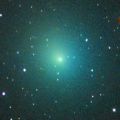
|
Now it is so bright as 4.7 mag (June 12, Marco Goiato). The apparent size is so large as 20 arcmin. Now it is brightest, and it keeps 4.5 mag in June. Now it is not observable in the Northern Hemisphere, but it will appear in the morning sky again at 5.5 mag in early July, then it keeps observable after that while the comet is fading gradually. In the Southern Hemipsphere, it keeps observable all the period until the comet fades out, although it will be low in mid June.
Date(TT) R.A. (2000) Decl. Delta r Elong. m1 Best Time(A, h)
June 21 4 47.81 -11 52.3 0.228 0.853 39 4.5 5:37 (274, 16)
June 28 4 0.52 -4 7.7 0.265 0.852 45 4.8 5:38 (255, 27)
|

|
Great outburst occured on Oct. 24, and it bacame a naked eye comet of 2 mag. It kept so bright as 5.5 mag still on Apr. 30 (Carlos Labordena), but it was extremely faint and difficult to see. The size was so large, the diameter was larger than 60 arcmin. It is not observable in this summer. But it will become observable in good condition in autumn again. The extremely faint large diffuse object may be detected with a best sky condition, around 5-6 mag with a diameter of 1 or 2 degrees.
Date(TT) R.A. (2000) Decl. Delta r Elong. m1 Best Time(A, h)
June 21 6 46.05 33 35.5 4.426 3.451 14 5.9 18:26 (121,-15)
June 28 6 56.81 33 11.6 4.469 3.479 11 6.0 18:28 (118,-18)
|
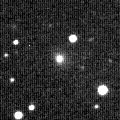
|
It is already very bright as 9.9 mag (June 6, Marco Goiato). Brightening well, and expected to be 6 mag in September. However, it keeps moving in the southern sky, and it is unobservable for a while in the Northern Hemisphere. It will appear in the evening sky at 6 mag in late September, but it keeps locating in the evening low sky until the end of 2008 when it fades out down to 9 mag. Then it turns to appear in the morning sky, and it keeps observable in the northern sky after that while fading gradually. In the Southern Hemisphere, it keeps observable until late October after this.
Date(TT) R.A. (2000) Decl. Delta r Elong. m1 Best Time(A, h)
June 21 6 33.30 -35 40.7 2.190 1.892 59 9.5 18:26 ( 60, 21)
June 28 6 48.63 -36 42.8 2.087 1.811 60 9.2 18:28 ( 58, 19)
|

|
It will reach to 11 mag in summer. It must have already brightened up to 12 mag, but the comet was not observed recently. The condition in this apparition is bad. In the Southern Hemisphere, it keeps extremely low, or under the horizon, so it will not be observable. In the Northern Hemisphere, it is not observable until August when it appears in the morning sky at 11 mag. After August, it keeps observable and fading in the morning sky.
Date(TT) R.A. (2000) Decl. Delta r Elong. m1 Best Time(A, h)
June 21 4 22.38 12 4.2 2.248 1.403 25 11.4 5:37 (250, 7)
June 28 4 44.13 14 22.5 2.221 1.384 26 11.3 5:38 (247, 7)
|
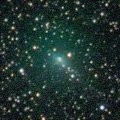
|
New bright comet. Brightening rapidly, and now it is so bright as 11.1 mag (June 7, Juan Jose Gonzalez). In the Northern Hemisphere, it keeps observable at 11-12 mag for a long time after this until autumn. It will move near by the Northern Pole from summer to autumn, and will be observable all night. Then it keeps observable until 2009 spring when the comet becomes faint. In the Southern Hemisphere, it will never be observable again.
Date(TT) R.A. (2000) Decl. Delta r Elong. m1 Best Time(A, h)
June 21 21 52.23 53 28.5 1.455 1.748 88 11.5 3:54 (180, 2)
June 28 21 57.18 59 31.4 1.463 1.736 86 11.4 3:32 (180, -4)
|
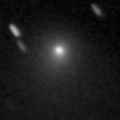
|
Now it is brightest at 10.9 mag (May 11, Marco Goiato). It will keep 11 mag for a long time until August. In the Southern Hemisphere, it keeps observable in good condition until summer. In the Northern Hemisphere, the altitude will never be higher than 30 degrees in the evening sky, and the comet will be unobservable in July. It will appear in the morning sky again at 13 mag at the end of 2008, then it keeps bright and observable for a while.
Date(TT) R.A. (2000) Decl. Delta r Elong. m1 Best Time(A, h)
June 21 10 47.29 -10 8.3 2.795 2.767 77 11.5 18:26 (132, 57)
June 28 10 57.57 -8 47.2 2.883 2.764 73 11.5 18:28 (127, 52)
|
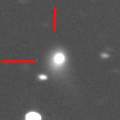
|
Now it is bright as 12.4 mag (June 7, Carlos Labordena), brightening almost as expected. It will reach to 10.5 mag and will be observable in good condition in 2008 autumn. It keeps observable, visible visually, brighter than 14 mag for one year until 2009 May.
Date(TT) R.A. (2000) Decl. Delta r Elong. m1 Best Time(A, h)
June 21 1 55.51 36 10.2 3.083 2.611 53 11.6 5:37 (208, 12)
June 28 2 9.74 38 10.9 3.003 2.584 56 11.5 5:38 (205, 11)
|
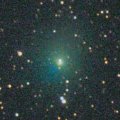
|
It reached up to 9.5 mag on Mar. 29 (Maik Meyer). Now it is fading slowly. It has already faded down to 10.7 mag (May 11, Marco Goiato). Diffuse object with a weak condensation. In the Northern Hemisphere, it will never be observable again. In the Southern Hemisphere, it keeps observable until it fades out.
Date(TT) R.A. (2000) Decl. Delta r Elong. m1 Best Time(A, h)
June 21 8 6.13 -14 38.0 2.064 1.595 49 11.9 18:26 ( 92, 29)
June 28 8 20.42 -17 49.4 2.130 1.658 49 12.1 18:28 ( 87, 28)
|
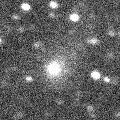
|
Now it is bright as 11.5 mag (June 7, Juan Jose Gonzalez). It keeps bright at 12 mag for a long time from 2008 spring to 2009 spring. However, it is only observable until August in the Northern Hemisphere because the comet moves southwards. It keeps observable for a long time in the Southern Hemisphere.
Date(TT) R.A. (2000) Decl. Delta r Elong. m1 Best Time(A, h)
June 21 16 48.89 -23 16.1 2.078 3.067 163 12.0 22:47 (180, 78)
June 28 16 33.96 -25 18.1 2.085 3.031 153 11.9 22:05 (180, 80)
|
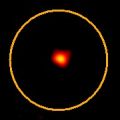
|
Now it is so bright as 11.6 mag (June 4, Alan Hale). It will be bright at 11-12 mag until July. However, it keeps locating extremely low for a while in the Northern Hemisphere. It will be getting higher gradually after late July, then it keeps observable while fading gradually.
Date(TT) R.A. (2000) Decl. Delta r Elong. m1 Best Time(A, h)
June 21 2 55.30 15 27.9 1.398 0.970 43 12.5 5:37 (232, 21)
June 28 3 26.20 18 19.4 1.433 0.973 42 12.2 5:38 (231, 18)
|
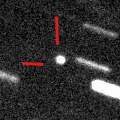
|
Now it is 13.8 mag (May 12, Juan Jose Gonzalez), brightening as expected and already visible visually. It is expected to reach to 6 mag in 2009 February. After this, it keeps observable until October when it becomes 11 mag.
Date(TT) R.A. (2000) Decl. Delta r Elong. m1 Best Time(A, h)
June 21 21 19.82 -14 16.5 2.279 3.053 131 13.1 3:23 (180, 69)
June 28 21 6.34 -15 10.7 2.109 2.977 142 12.9 2:42 (180, 70)
|
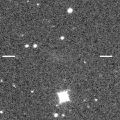
|
It approached to the sun down to 0.45 A.U. on June 19. In the Northern Hemisphere, it was observable in the morning low sky from mid May to mid June. Extremely diffuse. Michael Jager reported it was 13.5-14.0 mag on May 31, but it was not detected, fainter than 13 mag, on June 3 and 10. So maybe it disappeared before the perihelion passage. However, Mieczyslaw L. Paradowski and Juan Jose Gonzalez reported it was very bright around 11 mag visually in early June.
Date(TT) R.A. (2000) Decl. Delta r Elong. m1 Best Time(A, h)
June 21 6 1.69 45 21.4 1.184 0.450 21 12.9 18:26 (128,-27)
June 28 6 44.09 38 59.7 1.387 0.497 16 13.7 18:28 (122,-23)
|
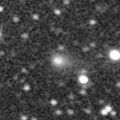
|
New comet. It is bright as 12.7 mag, and visible visually (May 12, Juan Jose Gonzalez). It keeps observable in good condition until autumn. But it is moving southwards gradually, and the altitude will be getting somewhat lower in the Northern Hemisphere. The calculation says it keeps bright at 13 mag for a while. However, it can be in a temporary outburst now, and it may be a very faint short periodic comet originally. It may fade out very rapidly after this.
Date(TT) R.A. (2000) Decl. Delta r Elong. m1 Best Time(A, h)
June 21 16 34.66 -15 53.9 1.501 2.475 158 13.7 22:34 (180, 71)
June 28 16 30.74 -16 26.9 1.544 2.485 151 13.8 22:02 (180, 72)
|

|
It was 15 mag on Jan. 14 (Michael Mattiazzo), brightening as expected. It will reach to 13.5 mag in the southern sky in spring and summer. In the Southern Hemisphere, it keeps observable for a long time after this. But in the Northern Hemisphere, it is not observable now. But it will appear in the morning sky at 15 mag in November, then it keeps observable while the comet will be fading slowly.
Date(TT) R.A. (2000) Decl. Delta r Elong. m1 Best Time(A, h)
June 21 6 55.79 -38 53.9 2.782 2.504 63 13.7 18:26 ( 60, 26)
June 28 7 18.69 -38 2.1 2.813 2.510 62 13.7 18:28 ( 60, 25)
|
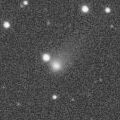
|
Now it is bright as 12.7 mag (Apr. 12, Marco Goiato). In the Northern Hemisphere, it will be getting lower gradually in the evening sky, and will be unobservable in late July. Then the comet will go southwards, so it will never be observable again in the Northern Hemisphere. In the Southern Hemisphere, it keeps observable in good condition for a long time until autumn.
Date(TT) R.A. (2000) Decl. Delta r Elong. m1 Best Time(A, h)
June 21 12 6.66 -6 1.0 2.790 3.036 94 13.8 18:26 (170, 61)
June 28 12 10.89 -7 16.1 2.867 3.023 88 13.8 18:28 (157, 61)
|
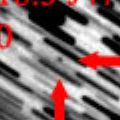
|
Now it is 16.5 mag (June 11, Juan Antonio Henriquez Santana). It will be brightening rapidly after this. It will reach up to 9 mag and keep bright for a long time from summer to autumn. In the Northern Hemisphere, it becomes low in the south at brightest, but it keeps observable until it fades out.
Date(TT) R.A. (2000) Decl. Delta r Elong. m1 Best Time(A, h)
June 21 19 24.04 14 14.7 0.578 1.492 137 14.7 1:27 (180, 41)
June 28 19 28.68 13 30.1 0.526 1.461 140 14.1 1:04 (180, 41)
|

|
Now it is not observable. In the last season, it became so bright as 10 mag in 2008 January. It will appear in the morning sky in late August.
Date(TT) R.A. (2000) Decl. Delta r Elong. m1 Best Time(A, h)
June 21 6 53.07 26 48.5 7.023 6.035 12 14.1 18:26 (116,-10)
June 28 6 59.04 26 36.7 7.043 6.037 7 14.1 18:28 (113,-14)
|
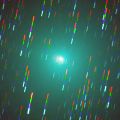
|
It passed near by Earth in early January, and it became a bright large object at 5.4 mag (Jan. 3, Seiichi Yoshida). It was visible with naked eyes. Now it is fading rapidly. It had faded down to 11.3 mag on May 10 (Marco Goiato). It has already moved away towards the southern sky, and it is no longer observable in the Northern Hemisphere. In the Southern Hemisphere, it keeps observable until it fades out.
Date(TT) R.A. (2000) Decl. Delta r Elong. m1 Best Time(A, h)
June 21 11 11.66 -55 20.6 1.772 2.228 102 14.1 18:26 ( 26, 66)
June 28 11 36.28 -53 31.7 1.873 2.298 101 14.6 18:28 ( 31, 67)
|
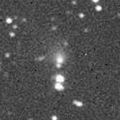
|
It is already bright as 14.7 mag and visible visually (Mar. 5, Seiichi Yoshida). It is expected to reach to 11 mag in 2009 summer. Because it moves in the northern sky, it keeps observable until it becomes brightest in the Northern Hemisphere. Although it had been low for a while, it will be getting higher gradually after this.
Date(TT) R.A. (2000) Decl. Delta r Elong. m1 Best Time(A, h)
June 21 3 55.23 59 16.2 5.433 4.727 41 14.6 5:37 (209,-19)
June 28 3 58.96 60 2.7 5.344 4.681 45 14.5 5:38 (207,-17)
|

|
Now it is 13.5 mag (May 8, Marco Goiato), bright and visible visually. It keeps observable visually at 13 mag at high location for a while.
Date(TT) R.A. (2000) Decl. Delta r Elong. m1 Best Time(A, h)
June 21 15 31.07 22 54.7 5.114 5.708 121 14.7 21:30 (180, 32)
June 28 15 24.00 22 57.7 5.205 5.719 115 14.8 20:56 (180, 32)
|

|
Now it is 16.1 mag, brightening well as expected (Mar. 30, S. G. McAndrew). It is expected to brighten up to 10 mag from late 2009 to early 2010. Because the comet moves in the southern sky for a long time, it keeps impossible or very hard to observe in the Northern Hemisphere until 2009 September. But after 2009 October, it is observable at 10 mag for a while in good condition. In the Southern Hemisphere, it keeps observable for a long time while brightening until 2009 June when it brightens to 11 mag. But it becomes unobservable around and after the brightest time.
Date(TT) R.A. (2000) Decl. Delta r Elong. m1 Best Time(A, h)
June 21 4 35.11 -36 33.4 5.715 5.335 63 15.4 5:37 (295, 31)
June 28 4 43.13 -36 39.3 5.629 5.278 64 15.3 5:38 (294, 35)
|
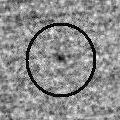
|
The nuclear magnitude was reported as 17.5 mag on June 7, but the total brightness will be already bright as 16 mag. It will be getting higher gradually after this. It will be observable at 15 mag in good condition until November.
Date(TT) R.A. (2000) Decl. Delta r Elong. m1 Best Time(A, h)
June 21 1 20.81 7 11.2 2.347 2.190 68 15.5 5:37 (216, 41)
June 28 1 33.54 8 8.3 2.265 2.176 71 15.4 5:38 (211, 42)
|

|
The condition in the Northern Hemisphere was very good in first half of May, and it was observed at 16 mag. It will approach to the sun down to 0.1 A.U. on June 17. If it shows a cometary activity, it may become much brighter than this ephemeris. However, it is not observable on the earth.
Date(TT) R.A. (2000) Decl. Delta r Elong. m1 Best Time(A, h)
June 21 6 15.45 22 49.5 1.214 0.211 3 15.4 18:26 (108,-14)
June 28 7 28.26 22 44.0 1.363 0.446 13 17.7 18:28 (114, -6)
|

|
Not observed in this return yet. But appearing in the morning sky. Now it must be brightest. Yasukazu Ikari reported it was fainter than 15 mag on June 16. It will be getting higher gradually after this. It will be observable in good condition until autumn when it becomes fainter than 18 mag.
Date(TT) R.A. (2000) Decl. Delta r Elong. m1 Best Time(A, h)
June 21 1 45.61 5 41.4 1.877 1.688 63 15.8 5:37 (224, 39)
June 28 2 2.87 7 10.9 1.835 1.690 65 15.8 5:38 (220, 39)
|
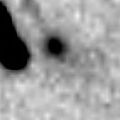
|
Now it is 15.3 mag (May 15, Ken-ichi Kadota). It keeps observable in good condition after this in the Northern Hemisphere. It will be fading gradually, and will be fainter than 18 mag in November.
Date(TT) R.A. (2000) Decl. Delta r Elong. m1 Best Time(A, h)
June 21 23 19.10 30 59.7 1.996 2.179 86 15.9 5:21 (180, 24)
June 28 23 22.68 34 39.6 1.976 2.213 89 15.9 4:57 (180, 20)
|

|
Now it is brightest at 16 mag. Moving northwards very fast, and it will be observable in good condition in the Northern Hemisphere after this. It keeps 16 mag until mid July. But it will be fainter than 18 mag in August.
Date(TT) R.A. (2000) Decl. Delta r Elong. m1 Best Time(A, h)
June 21 20 33.69 -34 28.3 1.280 2.190 144 15.9 2:38 (180, 90)
June 28 20 3.03 -31 26.8 1.254 2.228 157 16.0 1:40 (180, 87)
|
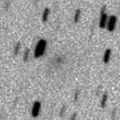
|
Now it is 16.8 mag (June 9, Yasukazu Ikari). It reaches to 16 mag from May to July, and observable in good condition.
Date(TT) R.A. (2000) Decl. Delta r Elong. m1 Best Time(A, h)
June 21 14 30.48 63 9.2 1.582 1.792 84 16.0 20:30 (180, -8)
June 28 14 25.37 56 15.3 1.575 1.806 85 16.1 19:57 (180, -1)
|
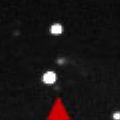
|
Now it is 17.6 mag (May 3, S. G. McAndrew). It will be 15.5 mag from July to October. It locates somewhat low in the Northern Hemisphere, but it keeps observable around 16 mag until winter.
Date(TT) R.A. (2000) Decl. Delta r Elong. m1 Best Time(A, h)
June 21 21 45.72 -28 9.5 2.329 3.075 129 16.4 3:48 (180, 83)
June 28 21 45.29 -28 22.0 2.248 3.059 135 16.3 3:20 (180, 83)
|
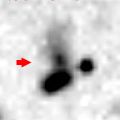
|
Now it is 17.2 mag (May 10, Gustavo Muler). It keeps observable while the comet will be brightening gradually after this. It will reach up to 14.5 mag in autumn. However, then it locates low in the evening sky, and it will be unobservable soon in December.
Date(TT) R.A. (2000) Decl. Delta r Elong. m1 Best Time(A, h)
June 21 15 30.14 -3 11.9 1.861 2.708 138 16.6 21:30 (180, 58)
June 28 15 26.85 -3 13.3 1.876 2.663 131 16.4 20:59 (180, 58)
|
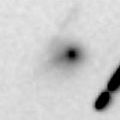
|
An outburst occured in late May, and it brightened up to 14.6 mag (May 23, Gustavo Muler). However, it faded down to the original brightness in late May. Now it is 17.2 mag (May 31, Katsumi Yoshimoto). It will reach to 14 mag in autumn, but it locates extremely low in the Northern Hemisphere. However, it keeps higher than 30 degree even in the Northern Hemisphere until August.
Date(TT) R.A. (2000) Decl. Delta r Elong. m1 Best Time(A, h)
June 21 11 17.25 27 47.9 1.736 1.693 70 16.8 18:26 (163, 25)
June 28 11 28.92 25 29.3 1.739 1.643 67 16.7 18:28 (158, 26)
|
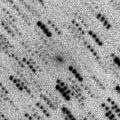
|
In April, it became so bright as 11.3 mag (Apr. 12, Marco Goiato). But CCD observers reported it was faint as 15 mag. It was difficult to see because extremely diffuse. In the Northern Hemisphere, it had been low until March, but now it locates high. But it is already fading. Mieczyslaw L. Paradowski reported it was 12.8 mag visually on June 6. However, no other visual observations have been reported since mid April.
Date(TT) R.A. (2000) Decl. Delta r Elong. m1 Best Time(A, h)
June 21 20 27.64 28 9.8 0.810 1.563 117 17.2 2:31 (180, 27)
June 28 20 20.82 28 41.4 0.836 1.618 121 17.5 1:56 (180, 26)
|
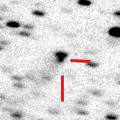
|
It was observed at 16.5-17 mag in 2006 and 2007. Because it is a very distant comet, it is observable at 17 mag still in 2008 in good condition.
Date(TT) R.A. (2000) Decl. Delta r Elong. m1 Best Time(A, h)
June 21 18 53.43 43 36.2 5.870 6.319 111 17.3 0:57 (180, 11)
June 28 18 44.69 44 9.1 5.879 6.338 112 17.4 0:20 (180, 11)
|

|
It will brighten up to 12 mag in 2012. It is faint still in 2008, but observable at 17 mag in good condition.
Date(TT) R.A. (2000) Decl. Delta r Elong. m1 Best Time(A, h)
June 21 23 36.10 8 31.5 10.830 10.912 91 17.6 5:37 (181, 46)
June 28 23 35.03 8 34.2 10.674 10.874 98 17.5 5:10 (180, 46)
|
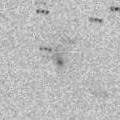
|
Now it is 16.8 mag (May 25, Ken-ichi Kadota). It keeps observable in good condition while the comet will be fading slowly.
Date(TT) R.A. (2000) Decl. Delta r Elong. m1 Best Time(A, h)
June 21 12 52.60 54 6.2 2.952 2.925 78 17.5 18:53 (180, 1)
June 28 12 52.90 50 29.3 3.026 2.948 75 17.6 18:28 (180, 5)
|

|
It had been observed at 16.5 mag for a long time from 2005 to 2007. Now it is fading. But it keeps observable at 17.5 mag in good condition for a long time until July.
Date(TT) R.A. (2000) Decl. Delta r Elong. m1 Best Time(A, h)
June 21 13 48.89 13 25.2 8.348 8.724 108 17.6 19:49 (180, 42)
June 28 13 47.62 12 53.0 8.476 8.751 102 17.7 19:20 (180, 42)
|

|
No observations have been succeeded since 2007 July. It was predicted to be so bright as 14 mag now. But actually, it is fainter than 19 mag and not detectable (June 1, Gustavo Muler). It will locate in good condition from spring to summer. But it seems to have already disappeared.
Date(TT) R.A. (2000) Decl. Delta r Elong. m1 Best Time(A, h)
June 21 22 20.35 7 58.4 1.619 2.174 109 20.2 4:23 (180, 47)
June 28 22 24.14 9 45.9 1.589 2.203 113 20.2 3:59 (180, 45)
|

|
It is expected to reach up to 7 mag in winter, and will be observable in good condition. However, this comet has not been observed since 1986. It was not detected, fainter than 18 mag, on May 31 (Katsumi Yoshimoto). It is predicted to be so faint as 21 mag still now. But it will brighten very rapidly near by the perihelion. It will be 18 mag in August. The condition of this apparition is good. It keeps observable for a long time until 2009 early summer both in the Northern Hemisphere and Southern Hemisphere.
Date(TT) R.A. (2000) Decl. Delta r Elong. m1 Best Time(A, h)
June 21 20 49.44 -22 55.7 1.609 2.484 141 21.6 2:52 (180, 78)
June 28 20 47.48 -23 10.2 1.496 2.420 148 21.1 2:23 (180, 78)
|
|
![]()
 C/2008 J1 ( Boattini )
C/2008 J1 ( Boattini ) C/2006 Q1 ( McNaught )
C/2006 Q1 ( McNaught ) C/2006 OF2 ( Broughton )
C/2006 OF2 ( Broughton ) C/2008 C1 ( Chen-Gao )
C/2008 C1 ( Chen-Gao ) C/2007 G1 ( LINEAR )
C/2007 G1 ( LINEAR ) 15P/Finlay
15P/Finlay C/2007 N3 ( Lulin )
C/2007 N3 ( Lulin ) C/2008 J4 ( McNaught )
C/2008 J4 ( McNaught ) P/2008 J2 ( Beshore )
P/2008 J2 ( Beshore ) C/2006 U6 ( Spacewatch )
C/2006 U6 ( Spacewatch ) C/2007 B2 ( Skiff )
C/2007 B2 ( Skiff ) 6P/d'Arrest
6P/d'Arrest 29P/Schwassmann-Wachmann 1
29P/Schwassmann-Wachmann 1 8P/Tuttle
8P/Tuttle C/2006 W3 ( Christensen )
C/2006 W3 ( Christensen ) C/2005 L3 ( McNaught )
C/2005 L3 ( McNaught ) C/2007 Q3 ( Siding Spring )
C/2007 Q3 ( Siding Spring ) 61P/Shajn-Schaldach
61P/Shajn-Schaldach 2008 HW1
2008 HW1 51P/Harrington
51P/Harrington C/2008 J6 ( Hill )
C/2008 J6 ( Hill ) C/2008 J5 ( Garradd )
C/2008 J5 ( Garradd ) C/2007 W3 ( LINEAR )
C/2007 W3 ( LINEAR ) 47P/Ashbrook-Jackson
47P/Ashbrook-Jackson 68P/Klemola
68P/Klemola 7P/Pons-Winnecke
7P/Pons-Winnecke 26P/Grigg-Skjellerup
26P/Grigg-Skjellerup C/2005 S4 ( McNaught )
C/2005 S4 ( McNaught ) C/2006 S3 ( LONEOS )
C/2006 S3 ( LONEOS ) C/2008 H1 ( LINEAR )
C/2008 H1 ( LINEAR ) C/2002 VQ94 ( LINEAR )
C/2002 VQ94 ( LINEAR ) C/2007 K3 ( Siding Spring )
C/2007 K3 ( Siding Spring ) 85P/Boethin
85P/Boethin![]()




























